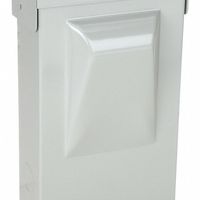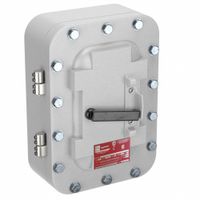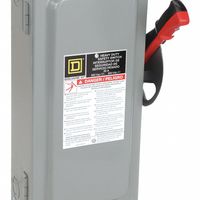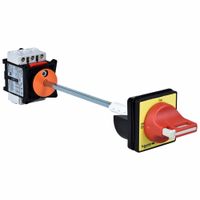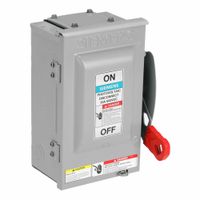Call +(254) 703 030 000 / 751 483 999 / 721 704 777
- Home
- Electrical
- Fuses Circuit Breakers Safety Switches
- Safety Disconnect Switches
.....Read More
Frequently Asked Questions
What is the purpose of a safety disconnect switch?
A safety disconnect switch, also known as an isolator switch or disconnector, serves the primary purpose of ensuring the safe maintenance and operation of electrical systems. It provides a means to completely de-energize a circuit or equipment, allowing for safe inspection, maintenance, or repair. By physically interrupting the flow of electricity, it protects personnel from electrical shock and prevents accidental startup of machinery during servicing.
The switch is typically used in industrial, commercial, and residential settings where electrical equipment requires regular maintenance. It is strategically placed to allow for easy access and quick operation in case of an emergency. In addition to maintenance safety, it also serves as a critical component in emergency shutdown procedures, enabling rapid disconnection of power in hazardous situations to prevent accidents, equipment damage, or fire.
Safety disconnect switches are designed to handle high electrical loads and are rated for specific voltage and current levels. They are often equipped with lockout/tagout capabilities, which allow maintenance personnel to lock the switch in the "off" position, ensuring that it cannot be turned back on until the lock is removed. This feature is crucial for compliance with safety regulations and standards, such as those set by OSHA.
In summary, the purpose of a safety disconnect switch is to provide a reliable means of isolating electrical equipment from its power source, ensuring the safety of personnel and equipment during maintenance and emergency situations.
How do you choose the right disconnect switch for an application?
To choose the right disconnect switch for an application, consider the following factors:
1. **Voltage and Current Ratings**: Ensure the switch can handle the maximum voltage and current of the system. Check both continuous and short-circuit current ratings.
2. **Type of Load**: Different loads (inductive, resistive, motor) require specific switch types. For example, motor loads need switches with higher interrupting ratings.
3. **Environment**: Consider the installation environment. For outdoor or harsh environments, choose switches with appropriate NEMA or IP ratings for protection against dust, water, and corrosion.
4. **Switch Type**: Decide between fusible and non-fusible switches. Fusible switches provide overcurrent protection, while non-fusible switches are used for isolation purposes only.
5. **Number of Poles**: Determine the number of poles required based on the system configuration (single-phase, three-phase).
6. **Mounting Style**: Choose between panel-mounted, wall-mounted, or floor-mounted switches based on space and accessibility requirements.
7. **Safety Features**: Look for switches with safety features like lockout/tagout capabilities, visible blade design, and interlocks to prevent accidental operation.
8. **Compliance and Standards**: Ensure the switch complies with relevant standards (e.g., UL, IEC) and local electrical codes.
9. **Manufacturer and Quality**: Choose reputable manufacturers known for quality and reliability to ensure long-term performance and support.
10. **Cost and Availability**: Consider the budget and availability of the switch, balancing cost with the required features and quality.
By evaluating these factors, you can select a disconnect switch that meets the specific needs of your application, ensuring safety, reliability, and compliance.
What are the differences between safety disconnect switches and motor disconnect switches?
Safety disconnect switches and motor disconnect switches serve distinct purposes in electrical systems, though they may appear similar.
Safety disconnect switches, also known as safety switches, are designed to provide a means to manually disconnect power to a circuit or equipment for maintenance or emergency purposes. They are used to ensure the safety of personnel by allowing them to isolate electrical equipment from its power source. Safety disconnect switches are typically used in various applications, including industrial, commercial, and residential settings. They are often equipped with features like lockout/tagout capabilities to prevent accidental re-energization during maintenance.
Motor disconnect switches, on the other hand, are specifically designed for use with motor circuits. They provide a means to disconnect power to a motor for maintenance, repair, or emergency shutdown. Motor disconnect switches are typically rated for the specific electrical characteristics of motor loads, such as high inrush currents and inductive loads. They are often used in industrial settings where motors are prevalent, such as manufacturing plants and processing facilities. Motor disconnect switches may also include features like overload protection and are designed to handle the specific demands of motor operation.
In summary, while both types of switches serve to disconnect power, safety disconnect switches are more general-purpose and used for a wide range of applications, whereas motor disconnect switches are specialized for motor circuits, with features tailored to handle the unique requirements of motor loads.
How do you install a disconnect switch safely?
1. **Preparation**: Ensure the power is turned off at the main breaker panel to prevent electrical shock. Use a voltage tester to confirm that the power is off.
2. **Select Location**: Choose a location for the disconnect switch that is easily accessible and close to the equipment it will control. Ensure it is mounted at a height that complies with local electrical codes.
3. **Gather Tools and Materials**: You will need a disconnect switch, appropriate gauge wire, wire strippers, screwdrivers, a drill, screws, and a voltage tester.
4. **Mount the Disconnect Switch**: Use a drill to mount the disconnect switch securely to the wall or a suitable surface. Ensure it is level and firmly attached.
5. **Wiring**:
- **Input Wiring**: Connect the incoming power supply wires to the line side terminals of the disconnect switch. Strip the wire ends, insert them into the terminals, and tighten the screws securely.
- **Output Wiring**: Connect the wires going to the equipment to the load side terminals of the disconnect switch. Strip the wire ends, insert them into the terminals, and tighten the screws securely.
6. **Grounding**: Connect the ground wire to the grounding terminal in the disconnect switch. Ensure all connections are tight and secure.
7. **Inspection**: Double-check all connections to ensure they are correct and secure. Make sure there are no exposed wires or loose connections.
8. **Testing**: Turn the main power back on and use a voltage tester to ensure the disconnect switch is functioning correctly. Test the switch by turning it on and off to verify it disconnects power as intended.
9. **Labeling**: Clearly label the disconnect switch to indicate its purpose and the equipment it controls.
10. **Compliance**: Ensure the installation complies with local electrical codes and regulations. If unsure, consult a licensed electrician.
What are the maintenance requirements for disconnect switches?
Maintenance requirements for disconnect switches include:
1. **Visual Inspection**: Regularly check for signs of wear, corrosion, or damage. Ensure that all components, including blades, contacts, and insulators, are intact and free from debris.
2. **Cleaning**: Remove dust, dirt, and any foreign materials from the switch components. Use appropriate cleaning agents that do not leave residues or cause corrosion.
3. **Lubrication**: Apply suitable lubricants to moving parts such as hinges and operating mechanisms to ensure smooth operation. Avoid over-lubrication, which can attract dust and debris.
4. **Tightening Connections**: Check and tighten all electrical and mechanical connections to prevent arcing and overheating. Loose connections can lead to increased resistance and potential failure.
5. **Contact Inspection and Maintenance**: Examine contacts for pitting, burning, or erosion. Clean or replace contacts as necessary to maintain good electrical conductivity.
6. **Mechanical Operation Check**: Operate the switch manually to ensure it moves freely and locks securely in both open and closed positions. Verify that the operating handle and linkage are functioning correctly.
7. **Thermal Imaging**: Use thermal imaging cameras to detect hot spots that may indicate poor connections or overloaded circuits.
8. **Testing**: Perform electrical tests such as insulation resistance and contact resistance tests to ensure the switch is functioning correctly and safely.
9. **Environmental Considerations**: Ensure that the switch is protected from environmental factors such as moisture, extreme temperatures, and corrosive elements. Use enclosures or protective coatings if necessary.
10. **Documentation**: Keep detailed records of all maintenance activities, inspections, and test results. This helps in tracking the condition of the switch and planning future maintenance.
11. **Compliance with Standards**: Follow manufacturer guidelines and industry standards for maintenance procedures and intervals to ensure safety and reliability.
Can disconnect switches be used in hazardous locations?
Yes, disconnect switches can be used in hazardous locations, but they must be specifically designed and certified for such environments. Hazardous locations are areas where flammable gases, vapors, dust, or fibers may be present in sufficient quantities to ignite or explode. Therefore, equipment used in these areas must meet stringent safety standards to prevent ignition.
Disconnect switches for hazardous locations are typically designed to be explosion-proof or intrinsically safe. Explosion-proof disconnect switches are constructed to contain any explosion within the device, preventing it from igniting the surrounding atmosphere. They are usually housed in robust enclosures made of materials like cast aluminum or stainless steel, which can withstand internal explosions.
Intrinsically safe disconnect switches, on the other hand, operate on the principle of limiting the energy available to a level below that required to ignite a hazardous atmosphere. This is achieved through the use of barriers and other protective measures that ensure the electrical circuits cannot produce sparks or heat sufficient to cause ignition.
When selecting disconnect switches for hazardous locations, it is crucial to consider the classification of the area, which is determined by factors such as the type of hazardous material present and its concentration. The National Electrical Code (NEC) and other international standards provide guidelines for classifying hazardous locations and selecting appropriate equipment.
In summary, disconnect switches can be used in hazardous locations if they are appropriately designed and certified for such use, ensuring they do not pose a risk of ignition in potentially explosive environments.
What are the safety standards and regulations for disconnect switches?
Safety standards and regulations for disconnect switches are primarily governed by organizations such as the National Electrical Code (NEC), the Occupational Safety and Health Administration (OSHA), and the National Electrical Manufacturers Association (NEMA) in the United States. Key standards include:
1. **NEC (NFPA 70):** The NEC provides guidelines for the installation and use of disconnect switches to ensure electrical safety. It specifies requirements for the location, accessibility, and labeling of disconnect switches to facilitate safe operation and maintenance.
2. **OSHA Regulations:** OSHA mandates that disconnect switches must be used to ensure the safety of workers during maintenance and repair activities. Lockout/tagout procedures (29 CFR 1910.147) are required to prevent accidental energization, and disconnect switches must be capable of being locked in the open position.
3. **NEMA Standards:** NEMA provides standards for the construction and performance of disconnect switches, ensuring they are suitable for their intended environment and application. This includes standards for enclosure types, such as NEMA 1, 3R, 4, 4X, and 12, which define the level of protection against environmental factors like dust, water, and corrosion.
4. **UL Standards:** Underwriters Laboratories (UL) certifies disconnect switches to ensure they meet safety and performance criteria. UL 98 is a key standard for enclosed and dead-front switches, ensuring they can safely interrupt the rated current.
5. **IEC Standards:** Internationally, the International Electrotechnical Commission (IEC) provides standards like IEC 60947-3, which covers low-voltage switchgear and controlgear, including disconnect switches, ensuring global compliance and safety.
These standards collectively ensure that disconnect switches are designed, installed, and maintained to prevent electrical hazards, protect personnel, and ensure reliable operation in various industrial and commercial settings.
